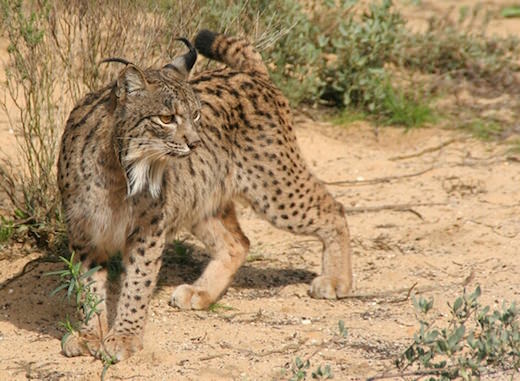Iberian Lynx

Critically endangered
Over the last 200 years or so, Iberian Lynx populations have drastically declined, so much so in fact that there are only two fully confirmed and very isolated breeding populations located in Southern Spain. Iberian Lynxes can be instantly recognised by their heavily spotted bodies complete with thick fur and long legs. They have short tails with black tips and are ordinarily a tawny colour with very dark spots. Their faces have a dark beard-like pattern around their mouths and their ears feature strikingly prominent black tufts. They’re predators, feeding mainly on rabbits, although ducks, partridges, and young deer are also eaten when rabbits are hard to come by.
Population Distribution
As mentioned, Iberian Lynx’s reside in Southern Spain. These big cats once thrived in Spain, Portugal, and even in parts of Southern France. By the year 1914 they were largely confined to southern Portugal and Spain. By the 1960’s, they were largely confined to Spain, covering around 10% of the surface of Spain. As Mentioned, there are only around 1000 of these cats left in the wild. They reside in sand dunes and heavily forested areas. As they are so severely under threat, Spanish governments have actually proposed seventy two separate protected sites to conserve the natural habitats of the animals. These sites will cover 2,750,000 hectares and are designed to help conserve their natural habitats and hopefully help them to breed and begin thriving once more.
Threats
Unfortunately, these cats aren’t dying out by accident, and not surprisingly it is human beings that have played a big role in their steady decline over the years. There are four main factors contributing towards their decline, and these include:
A decline in food – Rabbits are the main prey of Iberian Lynxes and thanks to their steady decline, also thanks to human beings, with diseases such as Myxamatosis drastically decreasing wild rabbit populations. Without the rabbits the Lynxes cannot eat, and if they can’t eat, they starve.
Loss of habitat – With large built up areas, infrastructure, the construction of buildings, and much more on top of that, much of the habitat of these Lynxes has been destroyed.
Hunting and road hits – With these animals being considered both prize hunting trophies and vermin, which is slightly ironic, they have therefore been hunted and killed for their fur, their meat, and by farmers and game keepers as they pose a threat to their live stock. With more and more roads being constructed, naturally more traffic is on the roads and so more of these animals are being struck and killed by these vehicles.